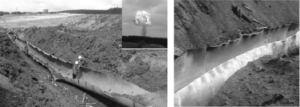CFD contours for back wind
This article enumerates the use of advanced FEA analysis for evaluating the structural behaviour of Economizer Heat Exchanger equipment. This is a heat exchanger with a bellow expansion joint and the reason of performing this study is a cause of a transition zone between two parts with different thickness, in order to determine if it exists risk in that zone. The heat exchanger design has been performed according to ASME VIII Div. 1 code using design by rules and shell thickness value obtained is 40 mm. On the other hand, the design of expansion joint has been performed according to Standards of the Expansion Joint Manufacturers Association (EJMA) and the minimum required thickness obtained is 30 mm. A discrepancy? keep reading if you are interested in what is going on.
SDEA advanced engineering team put their hands on the problem using design by analysis on the bellow design.
As a result of lock-in, resonant vortex-induced vibration (VIV) may occur, characterised by large amplitude oscillations which may lead to significant structural damage. Vortex-induced vibration is a major challenge in a range of industries such as; aerospace, oil & gas, power generation, manufacturing and civil infrastructure (such as high rise buildings, long span bridges, etc).

CFD Fluid induced vibration cone flowmeter SDEA
Another common type of flow induced vibration encountered in engineering systems is acoustic resonance vibration resulting from a non-linear interaction between the structure and high frequency pressure oscillations within the acoustic range. This type of FIV range is discussed in Part II of this Flow Induced Vibration series, the current blog entry will be primarily concerned with VIV. Two mitigation strategies may be taken to reduce the risk of damage due to VIV, the engineer can either:
- Try to modify the flow, creating smaller scale structures whose energy is more rapidly dissipated by the viscosity effect or.
- Modify the structure’s stiffness in order to move the natural modes of the structure to a higher frequency range and avoid resonance.
In many cases, the challenge arises from a failure of the design process to properly identify and assess any FIV sources and the structural or mechanical components that are at risk of developing FIV problems during installation or service. Computer Aided Engineering (CAE) techniques such as CFD and FEA offer a valuable tool for the fast and reliable assessment of FIV risk as well as an evaluation of potential mitigation strategies quite early on in the design process. This can lead to a reduction in development costs and an increase in the reliability of design.
How to address the problem: CFD and FEA assessment There are different alternatives to evaluate the likelihood of fluid induced vibration lock-in phenomena.
The classic approach uses non dimensional characteristics of the flow represented by invariants like Strouhal’s number. When this method is adopted different flow quantities involving geometric dimensions, velocity and material properties of the fluid are calculated to get a rough estimation for the main frequency excitation of the fluid, and that is directly compared with the natural mode frequencies of the structure. Normally a criteria based on a safety factor is assumed to get a safe design, some of our projects use a target requirement of 25% margin between the shredded fluid frequency and the natural harmonics of the structure. The main drawback of this simplified method is the non-conservative approach of assuming just a single forcing frequency and ignoring the wider frequency composition of the fluid forces. This is illustrated in the frequency plot in the Figure 2 below where the CFD predicted force signal is shown to have a much wider frequency composition than that indicated by a simple Strouhal number calculation.
With advances in CFD such as more accurate hybrid RANS-LES turbulence models and an increase in the available computing power, CFD has emerged as a reliable tool for the accurate simulation of turbulent flows and the associated fluid forces. Transient pressure pattern obtained from the CFD is obtain and using Fourier Analysis, these fluid force signals are decomposed into their spectral representation. Modal analysis using FEA may then be used to determine the natural frequencies of the structure and establish the likelihood of VIV occuring. In addition, FEA based harmonic response analysis may be used to evaluate the amplitude and stresses associated with the structural response. A detailed understanding of the structural response allows for the accurate assessment of structural fatigue life.

CFD FIV cone flowmeter SDEA
With advances in CFD such as more accurate hybrid RANS-LES turbulence models and an increase in the available computing power, CFD has emerged as a reliable tool for the accurate simulation of turbulent flows and the associated fluid forces. Transient pressure pattern obtained from the CFD is obtain and using Fourier Analysis, these fluid force signals are decomposed into their spectral representation. Modal analysis using FEA may then be used to determine the natural frequencies of the structure and establish the likelihood of VIV occuring. In addition, FEA based harmonic response analysis may be used to evaluate the amplitude and stresses associated with the structural response. A detailed understanding of the structural response allows for the accurate assessment of structural fatigue life.
SDEA’s specialist CFD and FEA services allow our clients to integrate ASME based assessments of fatigue life due to FIV into their design processes.
Industry test case: A cone Flow meter A Cone flow meter is a differential pressure flow measurement device widely used in Oil & Gas industry to obtain reliable flow rates for multiphase flows. The cone in the flow meter is subjected to high amplitude alternating turbulent forces that can potentially trigger vortex induced vibration of the cone under normal operating conditions, leading to component failure. A CFD model was used to simulate the most energetic turbulent length scales in the wake of the cone using advanced hybrid RANS-LES models and obtain the transient fluid forces acting on the flow meter structures. A FFT of the force time-series is used to obtain the spectral signature of the fluid forces. FEA based modal analysis is then used to compute the main vibrating modes of the structure as shown in Figure 3 below.

CFD fluid induced vibration SDEA FIV
The first bending mode of the structure – at 48 Hz – is shown to matches one of the high energy frequencies of the fluid force occurring at approximately 40 Hz. There is therefore a high likelihood of lock-in phenomena occurring and leading to resonant VIV unless the design is modified.
A new design configuration was developed, incorporating two additional support legs. This resulted in an increase in the frequency of the natural vibration mode and a reduction in the associated stresses levels.
Figure above shows the final design with stress contours for the first bending mode obtained from an FEA based harmonic response analysis. If you would like to know more about our team’s capabilities FIV and fatigue analysis or to discuss how we can help with your challenges in this area, please do get in touch. If you want to see an animation on FIV please visit our youtube channel and take a look to this video.




